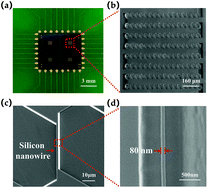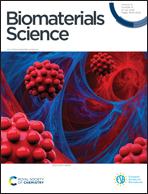A highly sensitive silicon nanowire array sensor for joint detection of tumor markers CEA and AFP†
Abstract
Liver cancer is one of the malignant tumors with the highest fatality rate and increasing incidence, which has no effective treatment plan. Early diagnosis and early treatment of liver cancer play a vital role in prolonging the survival period of patients and improving the cure rate. Carcinoembryonic antigen (CEA) and alpha-fetoprotein (AFP) are two crucial tumor markers for liver cancer diagnosis. In this work, we firstly proposed a wafer-level, highly controlled silicon nanowire (SiNW) field-effect transistor (FET) joint detection sensor for highly sensitive and selective detection of CEA and AFP. The SiNWs-FET joint detection sensor possesses 4 sensing regions. Each sensing region consists of 120 SiNWs arranged in a 15 × 8 array. The SiNW sensor was developed by using a wafer-level and highly controllable top-down manufacturing technology to achieve the repeatability and controllability of device preparation. To identify and detect CEA/AFP, we modified the corresponding CEA antibodies/AFP antibodies to the sensing region surface after a series of surface modification processes, including O2 plasma treatment, soaking in 3-aminopropyltriethoxysilane (APTES) solution, and soaking in glutaraldehyde (GA) solution. The experimental results showed that the SiNW array sensor has superior sensitivity with a real-time ultralow detection limit of 0.1 fg ml−1 (AFP in 0.1× PBS) and 1 fg ml−1 (CEA in 0.1× PBS). Also, the logarithms of the concentration of CEA (from 1 fg ml−1 to 10 pg ml−1) and AFP (from 0.1 fg ml−1 to 100 pg ml−1) achieved conspicuously linear relationships with normalized current changes. The R2 of AFP in 0.1× PBS and R2 of CEA in 0.1× PBS were 0.99885 and 0.99677, respectively. Furthermore, the sensor could distinguish CEA/AFP from interferents at high concentrations. Importantly, even in serum samples, our sensor could successfully detect CEA/AFP. This demonstrates the promising clinical development of our sensor.



 Please wait while we load your content...
Please wait while we load your content...